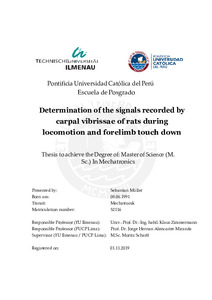| dc.contributor.advisor | Zimmermann, Klaus | |
| dc.contributor.advisor | Alencastre Miranda, Jorge Hernán | |
| dc.contributor.advisor | Scharff, Moritz | |
| dc.contributor.author | Müller, Sebastian | |
| dc.date.accessioned | 2020-09-04T14:37:34Z | |
| dc.date.available | 2020-09-04T14:37:34Z | |
| dc.date.created | 2019 | |
| dc.date.issued | 2020-09-04 | |
| dc.identifier.uri | http://hdl.handle.net/20.500.12404/16976 | |
| dc.description.abstract | Verschiedene Säugetiere, so auch Ratten, verfügen an ihren Pfoten über Tasthaare, die
sog. karpalen Vibrissen. Untersuchungen der Fortbewegung von Ratten haben gezeigt,
dass der Kontakt zwischen den karpalen Vibrissen und dem Untergrund Einfluss auf das
Fortbewegungsverhalten der Tiere hat. Karpale Vibrissen bestehen aus einem Haarschaft
und einem Follikel. Der Haarschaft ist lang, schlank, elastisch und im Follikel gelagert,
in dem sich die Mechanorezeptoren befinden. Ausgehend von Vorarbeiten der Fachgebiete
BiomechatronikundTechnischeMechanikderTechnischenUniversitätIlmenausowieder
Section of Mechanical Engineering, Pontificial Catholic University of Peru, wurde ein mech-
anisches Modell einer karpalen Vibrisse erstellt. Zielsetzung der vorliegenden Arbeit ist es,
die imFollikelwirkendenKräfteundMomente währendder FortbewegungeinerRatte zu
bestimmen. Aus den ermittelten Signalen sollen Rückschlüsse auf die Beschaffenheit des
Kontaktes zwischen Haarschaft und Oberfläche gezogen werden. Hierzu wurde die in einer
Vorarbeit ermittelte Bewegungsbahn einerRattenpfotemitdem indieserArbeit erstellten
mechanischen Modell kombiniert. Die daraus entstandene invers dynamische Analyse wurde
im Mehrkörpersimulationsprogramm ALASKA durchgeführt. Da nicht alle Eigenschaften
und Parameter des biologischen Vorbilds bekannt sind, wurden z.B. der Reibkoeffizient,
die Lagerungseigenschaften oder die Materialeigenschaften des Haarschaftes variiert. Als
Ergebnis der durchgeführten Parameterstudien konnten verschiedene Einflüsse bestätigt werden. Hierbei zeigen sich u. a. Effekte wie eine Änderung der Signalstärke sowie Än-
derungen in der Kontaktzeit. | es_ES |
| dc.description.abstract | Variousmammals, e.g. rats, have tactile hairs on their paws, the so-called carpal vibrissae.
Studies of the locomotion ofrats have shown that the contact between the carpal vibrissae
and the ground have an influence on the locomotion behaviour of the animals. Carpal
vibrissae consist of a hair shaft and a follicle. The hair shaft is long, slender, elastic and is
located in the follicle. The follicle includes the mechanoreceptors. A mechanical model of
acarpalvibrissawasdesignedonthebasisofpreliminaryworks fromtheBiomechatronics
Group and Technical Mechanics Group of the Technische Universität Ilmenau and the
Section of Mechanical Engineering, Pontificial Catholic University of Peru. The objective
ofthepresent work is to determine the forces and moments acting in the follicle during the
locomotion of a rat. From the determined signals, conclusions could be drawn about the
nature ofthe contact between hair shaft and surface. Forthis purpose, the in a preliminary
work determined trajectory of a rat’s paw was combined with the in this work created
mechanical model. The resulting inverse dynamic analysis was performed in the multi-body
simulation program ALASKA. Since not all properties and parameters of the biological
model are known, e.g.,the coefficient offriction,the support characteristics orthematerial
properties of the hair shaft were varied. As a result of the parameter studies, various
influences could be confirmed. Amongst other things, effects had been shown, such as a
change in signal strength and changes in contact time. | es_ES |
| dc.description.uri | Tesis | es_ES |
| dc.language.iso | eng | es_ES |
| dc.publisher | Pontificia Universidad Católica del Perú | es_ES |
| dc.rights | Atribución-CompartirIgual 2.5 Perú | * |
| dc.rights | info:eu-repo/semantics/openAccess | es_ES |
| dc.rights.uri | http://creativecommons.org/licenses/by-sa/2.5/pe/ | * |
| dc.subject | Sensores táctiles | es_ES |
| dc.subject | Mamíferos--Vibración | es_ES |
| dc.subject | Biomecánica | es_ES |
| dc.title | Determination of the signals recorded by carpal vibrissae of rats during locomotion and forelimb touch down | es_ES |
| dc.type | info:eu-repo/semantics/masterThesis | es_ES |
| thesis.degree.name | Magíster en Ingeniería Mecatrónica | es_ES |
| thesis.degree.level | Maestría | es_ES |
| thesis.degree.grantor | Pontificia Universidad Católica del Perú. Escuela de Posgrado | es_ES |
| thesis.degree.discipline | Ingeniería Mecatrónica | es_ES |
| renati.advisor.dni | 10588073 | |
| renati.advisor.orcid | https://orcid.org/0000-0001-8442-8255 | es_ES |
| renati.discipline | 713167 | es_ES |
| renati.level | https://purl.org/pe-repo/renati/level#maestro | es_ES |
| renati.type | http://purl.org/pe-repo/renati/type#tesis | es_ES |
| dc.publisher.country | PE | es_ES |
| dc.subject.ocde | https://purl.org/pe-repo/ocde/ford#2.00.00 | es_ES |






